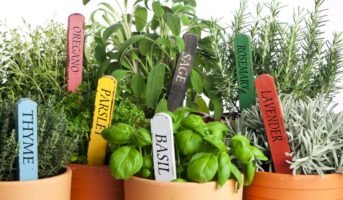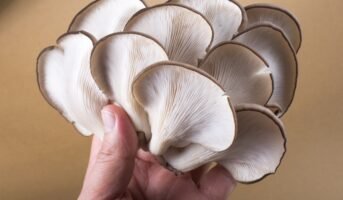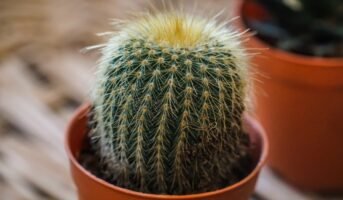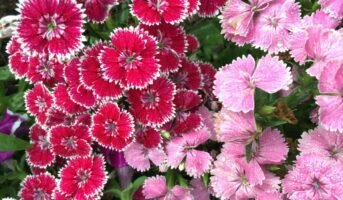Whether you are aiming to create flavour teas and aromatic oils, decorate a room or infuse your home with a delightful fragrance, lavender is the herb you will want to cultivate for its myriad of uses at home. With its charming blooms and distinctive foliage, lavender is a beloved choice among gardeners globally. If you are keen on incorporating this plant into your home or garden, read on to discover how to grow lavender.
Learn how to grow and care for Dianthus flowers
Lavender plant: Key facts
| Common name | Lavender |
| Botanical name | Lavandula spp. |
| Growing habit | Perennial |
| Bloom time | Summer |
| Sunlight requirements | Full sun |
| Soil requirements | Dry, well-drained, slightly alkaline |
Lavender: Characteristics
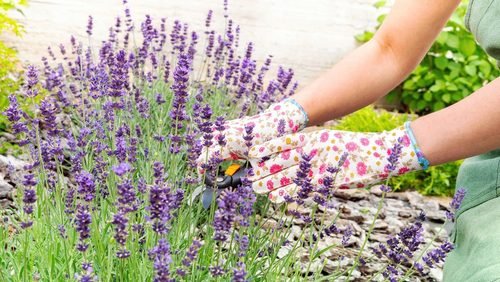
Lavender plants yield grey-green leaves with a refreshing, sweet herbal scent, accompanied by abundant, pretty flowers that emit the same fragrance. Both the leaves and flowers are edible. While lavender typically displays purple blooms, variants with pink or white flowers can be found. Originating from the Mediterranean and Europe, lavender can thrive in various climates. Considered easy to cultivate, especially with the right variety and growing conditions, lavender is hardy and well-suited to sunny, dry environments, making it a versatile choice for many garden types. Additionally, it boasts resilience against pests and diseases and requires minimal watering or fertilising.
Lavender: Varieties
With over 450 varieties of lavender available, it is essential to select the most suitable type based on your intended use. For a dwarf variety, ideal for perfuming your rooms, consider Hidcote English lavender (Lavandula angustifolia). Its deep purple flowers can be easily maintained for container growth. If you aim to incorporate sweet, light lavender leaves into your baked goods or culinary creations, Munstead English lavender is a great choice. For adding lavender stems to a tabletop vase, consider growing Kew Red or Spanish lavender, known for its striking flowers. French lavender (Lavandula dentata) is visually appealing with its serrated leaves, however, it is not as suitable for culinary purposes.

Where to plant lavender?
Lavenders thrive in a sunny spot where they can receive sunlight for most or all of the day. Avoid planting them under trees. Lavenders prefer well-draining neutral to alkaline soil. A raised bed in your garden provides the opportunity to control the soil composition. Even if the soil in the rest of your garden differs, a dedicated raised bed filled with sandy loam soil will be ideal for lavender. The elevated position helps keep the lavender plants away from pooling water in the garden. Earthen pots and planters are excellent choices for growing lavender as they keep the soil dry and allow for proper air circulation. Earthen pots are porous, promoting soil drainage. Avoid using plastic pots and planters.
When to plant lavender?
The optimal time to plant lavender in India is during the monsoon season, spanning from June to September. During this period, the soil tends to be moist, facilitating easier establishment of lavender plants. However, it is crucial to avoid planting lavender during heavy rainfall or flooding to prevent waterlogging and root rot. Lavender thrives in well-draining soil, hence, amending the soil with sand or grit is essential to enhance drainage. It might be preferable to plant lavender in the autumn or winter when temperatures are cooler, reducing the risk of heat stress. Before planting lavender in India, researching the specific growing conditions in your area is important.
How to plant lavender?
Growing lavender successfully begins with planting it properly. This perennial does not thrive in overcrowded conditions, hence, ensuring it has sufficient space to accommodate its flowers. Aim to space the plants as far apart as their mature height. Lavender requires good air circulation to thrive optimally. When planting lavender transplants, dig a hole deep enough for the plant’s roots and carefully place the plant, filling the soil around it. Avoid planting lavender deeper in the ground than it was in its nursery pot.
How to grow lavender?
Lavender seeds can be challenging to germinate, therefore, the simplest method to grow lavender indoors is to purchase young potted plants or transplants instead of growing them from seeds. Upon acquiring a new lavender plant, repot it into a container that is one or two sizes larger than the original one. Growing lavender in terracotta pots is effective as the herb prefers slightly drier conditions and water evaporates more rapidly from the pot’s porous material. When planting lavender, lightly prune the plants by removing all the growing tips. This practice encourages branching. Repeat this technique each year as new growth emerges. Water the plants until steady new growth becomes evident.
How to grow lavender from seeds?
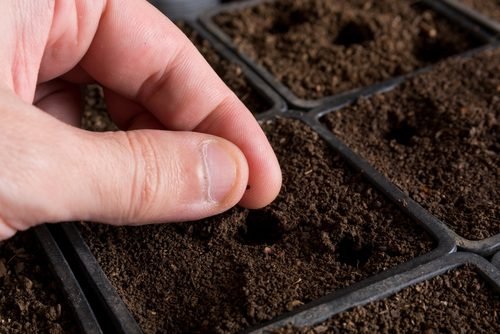
Growing lavender from seeds can be challenging, yet it is achievable.
- Sow the seeds in a sterile seed starting mix.
- Barely cover the seeds as they require light to germinate. Lavender seeds may take up to a month to germinate, although sometimes they may sprout in as little as 14 days.
- Facilitate the germination process by placing seed trays in a warm spot– around 70°F is an ideal temperature. Some gardeners refrigerate seeds in a sealed plastic bag for 21 days to prime them for sprouting and enhance germination.
- Transfer the seedlings to 2-inch wide pots once they have sprouted several sets of leaves. Lavender is a slow grower and may take 1-3 months to reach transplanting size.
- Fungus pose the greatest threat to lavender seeds and seedlings. Keep the soil mix moist but ensure good air circulation to mitigate disease outbreaks.
- Acclimatise the seedlings to outdoor growing conditions when the lavender plants are 3 inches tall.
Ideal climate for growing lavender
The lavender plant thrives best in dry, sunny and warm climates. The ideal temperature range for growing lavender is between 20-30°C, with the optimal soil temperature being approximately 18°C. Lavender is resilient and can survive in both cooler and warmer climates, although it flourishes in moderate temperatures. The plant requires exposure to bright sunlight for 6-8 hours daily.
Prolonged monsoon periods and high humidity levels can promote fungal growth and trigger infections in lavender plants. Extreme heat during summer can adversely affect the plant, causing wilting of leaves and stems. This may result in stunted growth and affect the quality of flowers and essential oil produced by the lavender plant. In regions with very cold temperatures (below 5°C or freezing point), frost can damage the plant. It is essential to protect lavender from direct contact with frost.
Some lavender varieties with spikes are better suited to colder climates, therefore, consider purchasing such varieties if you live in areas with low temperatures. There are various lavender plant varieties, each adapted to specific geographic locations, climate and soil. It is crucial to research and select the type of lavender that grows well in your area.
Best soil for growing lavender
Soil is crucial for ensuring the health and longevity of lavender plants. Lavender thrives in well-drained soil. Water accumulation at the plant’s base or in the soil that retains moisture can lead to root rot. Therefore, sandy, loamy soil is the most suitable for lavender plants. This soil is loose and prevents water pooling while providing essential nutrients, such as calcium, iron, magnesium, potassium and phosphorus, in appropriate amounts.
Sandy, loamy soil can be easily obtained online or from plant nurseries. It comprises sand, perlite, pumice, peat moss, lime, charcoal and worm castings, offering a balanced pH level, leaning towards alkalinity. This soil type facilitates proper drainage and allows air circulation around the roots. Avoid planting lavender in clay soil as it tends to be cold and moisture-retentive, leading to poor drainage and potential root rot.
Ideal soil pH for lavender plants
The optimal pH level for lavender plants ranges between 6.5 and 8. Lavender plants can tolerate varying soil pH levels, including neutral, acidic or alkaline, however, they tend to produce the best flowers in soil that leans towards alkalinity (with a pH of around 7.5) rather than neutrality or acidity (pH 6-7.5). Ideally, the soil should contain some chalk, which imparts alkalinity to the soil. To determine the soil’s pH levels before planting lavender seeds or saplings, purchase a pH testing kit. If the soil is too acidic, amend it by incorporating wood ash, chalk dust or lime to increase its alkalinity.
Lavender: Watering requirements
You may need to water the soil once every 7-14 days. Only water the soil when you notice that the upper layer (about 2 inches of the soil) is dry. This will allow the lavender plant to receive the necessary moisture, preventing suffocation or dehydration due to excessive or inadequate water. Higher temperatures lead to increased transpiration, necessitating frequent watering of the soil. During cold days, your lavender plant will slow its growth and functions, requiring less watering.
Lavender: Fertiliser or manure requirement
Lavender plants originated in semi-arid regions, therefore, they do not require very fertile soil. Manure is not necessary; in fact, frequent application of manure can damage the lavender plant’s root and weaken its immunity, making it more susceptible to winter injury. Excessive manure can introduce too much nitrogen into the soil, causing the plant’s branches to grow excessively with more foliage at the expense of flowers, resulting in poor blossoming.
However, after the first year, consider adding a small amount of slow-release compost or manure to the soil at the beginning of each spring to replenish the nutrients used by the lavender without overwhelming the lavender plant with excess manure.
It is important to consult with an expert gardener before applying any fertilisers.
Lavender: Pruning requirements
Pruning is crucial for successfully growing lavender. As lavender ages, its stems become woody. Pruning slows down this process as woody stems do not produce new growth, essential for flowering. It is best to prune lavender from late summer to fall, after flowering, to enhance air circulation and remove excess branches, preventing winter damage. In colder regions, pruning in spring may be necessary to remove stems affected by winter. When pruning establishes lavender plants, remove at least one-third of all growth, avoiding cutting into the woody area as buds on these stems would not sprout.
How to take care of the lavender plant during winter?
If your lavender plant is in the garden, it is important to prune it before winter sets in. Trim off any new stems, however, leave the woody part of the plant untouched. If there is forecasted snow or frost, covering the lavender with a tarpaulin shade will offer protection. Watering should be minimal during this time. For potted lavender plants, bring them indoors when it snows. Ensure the room has good air circulation, normal temperature and receives enough sunlight.
How to take care of the lavender plant during monsoon?
If your area experiences heavy rainfall during the monsoon, it is advisable to opt for other flowering plants that thrive in moist conditions and water-retaining soil as lavender plants may not fare well in such environments.
In regions with intermittent rainfall, you can bring potted lavender plants indoors during rainy days and place them back once the rain subsides. For lavender planted in the garden, covering them with plastic crates during rainfall can offer protection.
Before planting lavender seedlings, conduct a soil test to assess water retention capabilities. After a rainy spell, observe if the soil adequately drains excess water. If it does, it indicates a suitable environment for lavender plants, ensuring they remain unharmed even after rainfall.
How to take care of lavender plants during summer?
Due to the risk posed by high temperatures, lavender plants require special care during hot summers. Ensure they receive ample sunlight for 6-8 hours a day but provide shade in the afternoon to shield them from intense heat. For garden plants, using large umbrellas is advisable.
Water deeply only when the top two inches of soil are completely dry. To maintain moisture and regulate soil temperature, mulch around the base of the plants. Regular pruning is essential to promote air circulation and remove spent blooms, encouraging continuous flowering. It is important to watch out for pests, such as aphids, and use natural remedies, such as neem oil.
How to grow lavender indoors?
While lavender may not be a traditional houseplant, it can thrive indoors with proper care. Here are some tips for growing lavender indoors:
- Choose the right variety: Opt for smaller lavender varieties that adapt to pots and fit beneath a growth Canary Island lavender (Lavandula canariensis), French lavender (Lavandula dentata) and fern leaf lavender (Lavandula multifida) are suitable for indoor cultivation.
- Select a suitable container: Use a pot that is only 1-2 inches larger than the plant’s root ball to prevent waterlogging and root rot. Terracotta pots are ideal as their porous clay sides help regulate moisture levels.
- Ensure ideal soil conditions: Lavender thrives in lean soil. Use a soilless mix made for containers and add limestone gravel at the bottom of the pot for drainage. Incorporate lime into the soil for alkalinity and blend dried, ground eggshells monthly to add lime.
- Provide sufficient light: Place indoor lavender plants near a south-facing window or use supplemental light like fluorescent tubes.
- Watering: Water the plant thoroughly, allowing the soil to dry slightly between waterings to prevent root rot. Avoid over-watering, however, do not let the soil go completely dry to prevent yellowing leaves.
- Fertilise: Use half-strength, all-purpose water-soluble fertiliser every four weeks during spring and summer to promote healthy growth.
- Pruning: Regularly prune lavender to encourage new growth and maintain a fuller appearance. Tip prune occasionally for bushiness but avoid constant pruning to ensure adequate flower production.
How to harvest lavender flowers?
Plants reach their peak bloom during their third year of growth. Healthy, mature plants, when not overcrowded, can produce up to 1,000 flower stems per plant. When harvesting lavender flowers:
- Use sharp scissors or pruners to cut stems.
- For culinary use, select fresh, fully open blooms, avoiding those that are spent or dried.
- For bouquets, cut stems when approximately 3/4 of the individual buds on a flower spike are open, including a few lower buds. This stage offers the highest concentration of essential oils, resulting in a rich fragrance.
- Dry lavender flowers by bunching them together and hanging them upside down in a dry, dark, warm location. Alternatively, arrange flowers upright in a vase without water. Drying time varies based on humidity, however, it typically takes 7-14 days.
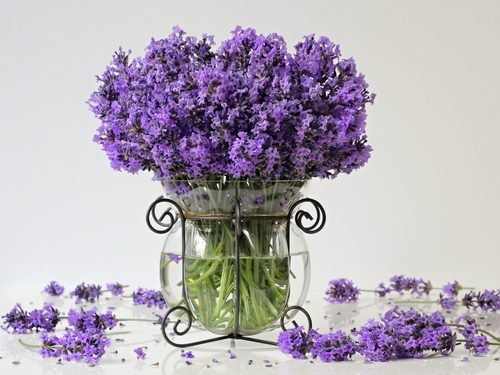
How to prevent and treat root disease in lavender plants?
Maintaining the health of your lavender plant’s roots is straightforward. Here are some tips to follow:
- Ensure proper soil drainage. Water should flow freely and not accumulate around the base of the plant.
- Regularly inspect your lavender plant for any signs of root disease. If you notice changes in stem texture or if branches begin to wither or drop, despite healthy growth in spring, trim away the affected areas. Examine the roots and cut out any rotten sections. Allow the roots to air dry for 24 hours before replanting. If your lavender is in a pot, replace the soil. In a garden setting, remove and replace the soil where the lavender was growing.
- Prune back a few leaves from the lavender plant when it is This reduces the workload on the roots.
- Treat the affected plant with cinnamon or hydrogen peroxide to eliminate bacteria and fungus that may be causing the rot.
Uses of lavender plant
Lavender has been used for centuries, with historical applications in mummification by the Egyptians and bathing rituals by the Romans. Common uses of lavender include culinary and crafting purposes.
- Lavender flowers and young leaves add a sweetly herbal flavour to desserts, beverages, sauces and marinades.
- Lavender can substitute for rosemary in recipes, using twice as much lavender as rosemary.
- It can infuse meat marinades or rubs with a unique savoury flavour and impart a smoky herbal essence when tossed onto hot grill coals.
- Lavender blooms can be harvested for fresh bouquets or dried for crafting projects like sachets, wreaths or potpourri.
- Lavender buds make excellent additions to handmade candles or soaps.
- Lavender aromatherapy oil can be made using lavender buds or flowers and common household ingredients.
Health benefits of lavender
- Improves sleep quality: The soothing properties of lavender promote good Research indicates that inhaling lavender before bedtime can enhance sleep quality and duration, offering a natural remedy for insomnia or sleep disturbances.
- Reduces stress and anxiety: Lavender is renowned for its calming fragrance, scientifically proven to reduce anxiety and stress. Inhaling lavender essential oil or using lavender-infused products can promote relaxation and alleviate tension.
- Relieves pain: Lavender’s analgesic properties make it effective in relieving Whether applied topically as an oil or used in aromatherapy, lavender reduces headaches, migraines and muscle soreness.
- Antiseptic and antimicrobial properties: Lavender possesses natural antimicrobial and antiseptic qualities, contributing to its effectiveness in wound care. When applied topically, it can help cleanse and protect minor cuts, burns or insect bites.
- Anti-inflammatory effect: Lavender contains compounds with anti-inflammatory effects, making it valuable for soothing inflamed skin conditions, such as dermatitis or eczema. Applying lavender-infused creams or oils may alleviate discomfort associated with inflammation.
- Enhances respiratory health: Inhaling lavender vapour or using lavender in steam inhalation can assist in respiratory health. Its anti-inflammatory and soothing effects may provide relief from symptoms associated with respiratory conditions like colds or allergies.
- Boosts cognitive function: Some research suggests that lavender may offer cognitive benefits. Inhalation of lavender essential oil has been linked to improved cognitive performance and
- Elevates mood: The delightful aroma of lavender is associated with mood enhancement. Whether used in aromatherapy or incorporated into personal care products, the scent has mood-lifting effects, promoting a sense of well-being.
Lavender plant: Vastu
The rich purple hue of the lavender plant signifies prosperity and abundance according to Vastu Shastra. Introducing this indoor plant into your living or work space facilitates personal growth and attracts favourable opportunities. Lavender plants emit calming fragrances that soothe the environment and its occupants. These plants foster happiness and prosperity. For optimal results, Vastu suggests placing lavender plants in bedrooms to promote a contented life, preferably in the north, northeast or east directions.
Lavender cultivation in India
In India, lavender cultivation is predominantly done in Himachal Pradesh, Jammu and Kashmir and Uttarakhand. Agriculture experts assert that Himachal Pradesh, situated in northern India, stands out as the most favourable region for growing lavender. The state boasts a mild climate, characterised by low humidity and abundant sunshine, which are ideal for the herb’s development. Moreover, the region features well-drained soil, a crucial factor for successful lavender cultivation.
Beyond Himachal Pradesh, Uttarakhand, with its hilly terrain and ample sunlight, offers an advantageous environment for plant growth. Similarly, Jammu and Kashmir, along with certain areas of Punjab, have displayed promising lavender yields. It has emerged as a significant centre for lavender cultivation, particularly with the initiation of the Aroma Mission.
Challenges of lavender cultivation in India
Lavender cultivation is not widespread across India due to the following factors:
- Lavender is a temperate plant, requiring specific climate and soil conditions. The varying climatic zones across India may not always provide the necessary environment for successful cultivation.
- Limited awareness and expertise in lavender cultivation have hindered its widespread adoption. Farmers lack the knowledge and skills required to effectively grow and manage lavender crops.
- Unlike staple crops, such as rice or wheat, lavender does not have a well-established market in India. The absence of a robust market infrastructure makes it less appealing for farmers to invest in lavender cultivation.
- The high initial investment required to establish a lavender farm poses a significant hurdle for many farmers. From acquiring suitable land to investing in infrastructure and resources, the upfront costs can be prohibitive.
- Climate change presents additional challenges for large-scale lavender cultivation. Shifts in weather patterns and unpredictable climatic conditions impact the viability and productivity of lavender crops, complicating cultivation efforts.
In a nutshell
Cultivating lavender at home offers a multitude of benefits, from its aesthetic appeal to its diverse use in cooking, crafting and promoting health and well-being. Lavender’s resilience and adaptability make it a suitable choice for various garden types and climates provided it receives ample sunlight and well-drained soil. By understanding key factors, such as planting, watering, pruning and care during different seasons, gardeners can successfully grow and maintain lavender plants. With its rich history and proven health benefits, lavender remains a beloved herb worldwide.
FAQs
How do I grow lavender?
To grow lavender successfully, choose a sunny spot with well-drained soil. Ensure the soil is slightly alkaline and amend it with sand or grit for better drainage, if needed. Water lavender plants once every 7-14 days when the top 2 inches of the soil are dry. Prune lavender in late summer to promote air circulation and prevent winter damage. Avoid over-fertilising and provide adequate space between plants for optimal growth.
How do I plant lavender?
When planting lavender, ensure it has enough space to accommodate growth. Dig a hole deep enough for the plant’s roots and tuck it into place, snugging soil around it. Avoid planting lavender deeper than it was in its nursery pot.
What type of soil is best for growing lavender?
Lavender thrives in well-drained, sandy, loamy soil that is slightly alkaline. Amend soil with sand or grit to enhance drainage.
Should I use pots or plant lavender directly in the garden?
Both options work well. Use earthen pots or planters with well-drained soil to ensure air circulation and moisture control. Raised beds filled with sandy, loamy soil are ideal for garden planting.
Can I grow lavender from seed?
Yes, but it can be challenging. Plant lavender seeds in a sterile seed starting mix and barely cover them as they need light to germinate. Keep the soil moist and warm and transplant seedlings once they have several sets of leaves.
What is the ideal climate for growing lavender?
Lavender thrives in dry, sunny climates with moderate temperatures between 20-30°C. It can tolerate both cooler and warmer climates but may suffer in prolonged monsoons or extreme heat. Choose lavender varieties suited to your climate.
| Got any questions or point of view on our article? We would love to hear from you. Write to our Editor-in-Chief Jhumur Ghosh at [email protected] |

Dhwani is a content management expert with over five years of professional experience. She has authored articles spanning diverse domains, including real estate, finance, business, health, taxation, education and more. Holding a Bachelor’s degree in Journalism and Mass Communication, Dhwani’s interests encompass reading and travelling. She is dedicated to staying updated on the latest real estate advancements in India.
Email: [email protected]



